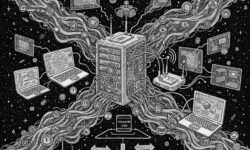
Why OpenUSD Is Suddenly Everywhere
3D projects used to be islands. One team worked in a DCC, another in a game engine, and the handoff was a stack of exports with notes. Change anything and the whole pipeline shifted like sand. OpenUSD changes that. It’s a scene description that is non‑destructive, layered, and composable. Instead of flattening work into a single file, you build a shared world where every department contributes without stepping on each other.
That matters far beyond film. Product teams preview designs on the web and in AR. Robotics teams simulate factories. Retailers need consistent 3D assets across e‑commerce and stores. OpenUSD gives everyone a stable, readable, and automatable format for building and reusing 3D at scale.
Core Ideas You’ll Actually Use
You don’t need to memorize the entire spec to get real value. Anchor your pipeline around a few concepts that keep projects tidy and fast.
Prims, Stages, and Layers
- Prim: The building block. A mesh, light, camera, or transform. Prims live on a stage, which is the current view of your scene.
- Layer: A file that describes some part of the stage. Layers compose on top of each other. You can add detail, override properties, or mute a layer without breaking the base.
- Composition arcs: The “glue.” Use references to include assets; payloads to defer loading heavy data; inherits to share properties; and overrides to tweak anything non‑destructively.
Variants and Organization
Variants let you switch between options without duplicating assets. A chair prim might have color=red/blue/green and legs=wood/metal. You select variants at any level: per shot, per product SKU, per platform. Keep variant sets small and purposeful. Exploding variants into every combination can kill performance and sanity.
References vs. Payloads
- Reference pulls another file into your stage immediately. Use it for small assets or critical context.
- Payload is a reference you can load later. Great for huge environments and heavy rigs.
Hydra and Renderers
USD’s Hydra is a rendering architecture. Think of it as a plug‑and‑play layer between your scene and your renderer. Storm (the default), Arnold, Karma, and others are Hydra delegates. This makes swapping or comparing renderers across the same stage much easier.
Designing a Minimal, Durable OpenUSD Pipeline
Start with a small, opinionated structure. It should be boring on purpose. Boring scales.
A Simple, Scalable Folder Layout
project/
stages/
scene_root.usda
shots/
s010.usda
s020.usda
assets/
props/
chair/
chair_model.usda
chair_look.usda
chair_variants.usda
textures/
env/
studio_light.usda
showroom.usda
materials/
shared_materials.usda
clips/
chair_anim.usda
schemas/
meters_up_axis.usda
- scene_root.usda references environments, props, and materials. Keep it thin.
- Each asset gets its own directory with model, look (materials), variants, and textures.
- shots/ holds minimal overrides: camera, timing, and variant selections.
- materials/ centralizes shared looks and patterns to avoid duplicates.
Units, Axes, and Conventions
Pick one and document it. Set metersPerUnit and upAxis explicitly in a base schema layer and reference it everywhere. A common setup is meters and Y‑up for product/film, or Z‑up for some robotics. Tie this to a linter so mismatches are caught early.
Naming and Paths You Won’t Regret
- Use stable prim paths: /World/Env/Showroom, /World/Props/Chair. Avoid spaces and special characters.
- Keep names semantic rather than DCC‑specific: Chair_GRP is worse than Chair.
- Add purpose attributes: guide, proxy, render to control visibility by context.
Materials and Textures Without Chaos
There are many shading systems. You want portability and lower friction.
MaterialX First
MaterialX is a high‑level description for look‑dev. It travels well across tools and can be lowered to shader code per renderer. Store canonical materials in MaterialX nodes inside USD, then adapt as needed. You avoid locking to a single renderer early.
Texture Guidelines That Save Storage
- Make basecolor sRGB, others linear.
- Use UV name consistency across assets to prevent special cases.
- Prefer compressed textures for runtime sinks (e.g., KTX2) and EXR for high‑fidelity offline work.
- Keep texture resolution variants via USD variants or separate look layers.
Collaboration That Actually Scales
OpenUSD shines when multiple teams edit different layers and see a live, composed stage. The trick is to define boundaries for who edits what.
Department Layers
- Modeling: owns topology and transforms in asset_model.usda.
- Shading: owns bindings and parameters in asset_look.usda.
- Layout: references assets into the world and sets transforms in scene_root.usda.
- Lighting: overrides lights and visibility in per‑shot layers.
- Animation: author time‑sampled transforms or clip sets in clips/.
Each team works in their layer and never bakes over another department’s source. If you need to change something upstream, add a targeted override layer or make a clean PR to that department’s repo.
Version Control That Respects USD
- Store USDA (ASCII) for diffs on small and mid‑sized layers.
- For heavy binary layers (USDC), keep human‑readable proxies alongside (e.g., JSON manifests) for code reviews.
- Write a pre‑commit linter that checks units, upAxis, required metadata, and forbids hardcoded absolute file paths.
Live Review Without Ping‑Pong
Use a USD viewer that supports live reloading. Artists save; supervisors refresh; everyone sees the same composed result. Because changes sit in layers, it’s obvious who changed what. If your tool supports session layers, you can try overrides in review without writing them to disk, then save only the useful ones.
Performance: Keep Stages Snappy
USD can handle enormous scenes if you tell it where to look and what to load.
Load Less by Default
- Payloads for heavy assets. Only load the payload when needed.
- Population masks to limit traversal to a handful of prims, like /World/Props/*.
- Use purpose=proxy for fast previews; switch to render purpose for beauty.
Instancing and Point Instancers
Cloned objects (trees, bolts, seats) should be instanced, not duplicated. For thousands of items, a PointInstancer describes transforms and a few prototypes. You save memory and improve render speed dramatically.
Bounding Boxes and Visibility
- Maintain accurate extent metadata on meshes for reliable culling.
- Toggle visibility strategically in overrides to avoid pushing giant chunks of scene through the pipeline.
Animation Clips and Time
For reusable animation, store it as clip sets and retarget via references. Time‑sampled transforms increase file size quickly. Keep samples only where needed and ensure curve precision is reasonable. For quick scrubbing, consider proxy animation with minimal channels on low‑poly proxies.
From and To Everything Else: FBX, glTF, USDZ
You’ll still talk to other formats. Plan the rules.
FBX for Legacy Apps
- Use FBX when a DCC or CAD workflow requires it. Export from USD with a strict unit and axis check.
- Beware pivot mismatches and constraints that don’t map 1:1. Bake transforms when in doubt.
glTF for Lightweight Runtimes
- glTF is excellent for web viewers and real‑time apps. Convert USD assets to glTF for deployment, not for authoring.
- Stick to PBR metallic‑roughness for best fidelity. Many node graphs will need simplification.
USDZ for iOS Quick Look and AR
- USDZ is a zipped bundle of USD and supporting files. Validate materials and texture formats for iOS.
- Keep polygon counts sane and ensure meters are correct. AR anchors depend on scale.
Robotics, Simulation, and Digital Products
OpenUSD isn’t just for pictures.
Physics and Robotics
- Use physics schemas to mark collision shapes, mass, and joints. You can swap physics engines without rewriting scene structure.
- Author semantic tags (e.g., material=steel, zone=safe) as custom metadata. Downstream systems can read them for rules and analytics.
Product Configurators
Variants are your friend for SKUs. Create color, finish, and component variant sets. Keep inventory data in a separate JSON or CSV and write a small tool to resolve the correct USD stage for a given SKU. The same assets feed photography, AR, and interactive web views with consistent looks.
Common Pitfalls—and Simple Fixes
Scale Drift
Mismatched units cause cameras and physics to behave oddly. Fix by centralizing a schema layer that sets metersPerUnit and upAxis, and refuse merges that violate it.
Variant Explosion
Don’t make variants for everything. If two attributes are independent, keep them in separate sets and select them in a higher‑level layer. If you need to preview many combos, generate them on demand instead of baking all permutations.
Texture Bloat
Establish a reference texture library, with enforced naming and resolution tiers. Use a packing policy (e.g., AO in B, roughness in G, metalness in R) only if your target renderer expects it. Don’t pack for offline renders where clarity matters more than a few megabytes.
Overusing Overrides
Overrides are great until they aren’t. If an override becomes permanent or widespread, fold it into the source layer the right team owns. Otherwise, you’ll end up with a nest of overrides that nobody wants to untangle.
Measuring a Healthy USD Pipeline
Pipelines fail in slow motion. Track these metrics and review them weekly.
- Time to first pixel: From stage open to first interactive frame.
- Stage acreage: Number of prims loaded by default vs. needed for a task. Smaller is better.
- Asset reuse rate: How often a prim from assets/ appears in different projects.
- Review friction: How many clicks to comment, apply, and commit a tweak from a review session.
- Render parity: Differences between Hydra delegates for the same look. Aim for predictable deltas.
Automation: The Secret Ingredient
USD is easy to script. A few small tools remove most of the manual pain.
Linters and Checkers
- Validate units, upAxis, required metadata, texture paths, and purpose attributes.
- Flag world scale outliers and missing extent fields.
Stage Builders
A tiny Python tool that reads a JSON spec and outputs a composed stage for any product variant or shot. You can build “recipes” that marketing and engineering both trust.
Material Translators
Keep canonical looks in MaterialX. On export, convert to the renderer’s shader network, or to glTF PBR for web. Automate the boring transforms, and your artists can stay focused on quality.
Viewers and Tools You Can Start With Today
You don’t need a monolithic stack. Combine simple, interoperable pieces to get started quickly.
Essential Tools
- usdview for inspection and debugging. It’s fast and shows composition details.
- A DCC with USD support (Blender, Maya, Houdini). Use it to author, but keep your ground truth in USD layers.
- A renderer with a Hydra delegate for consistent previews across machines.
Helpful Add‑Ons
- Reality Converter for USDZ packaging and quick iOS checks.
- glTF exporters for web pipelines. Validate with a web viewer before deployment.
- Simple command‑line usdcat, usddiff, and usdchecker scripts in CI to catch issues early.
A Day in the Life of an Asset
Let’s walk a realistic path for a chair used in a configurator and a product video.
- Modeling creates chair_model.usda with correct scale and extent.
- Shading adds chair_look.usda with MaterialX materials and packed textures.
- Variants arrive in chair_variants.usda: legs metal/wood, finish matte/gloss.
- QA runs a linter. A missing extent field is fixed; a texture path is normalized.
- Layout references the chair into showroom.usda and places a few instances.
- Lighting adds a softbox rig in a shot layer. A review session suggests a warmer key; the change is saved as an override, then merged into the lighting layer.
- Web Team triggers a script that resolves the USD stage for SKU X, converts to glTF with the selected variants, and publishes KTX2 textures.
- Marketing requests AR previews. The same stage bundles as USDZ, validated on iOS.
At every step, the chair remains a single source of truth. No stray FBX copies. No duplicated textures with random names. And when the client asks for a new finish, it’s a variant, not a rebuild.
Security and Integrity in Shared 3D
High‑value assets move between vendors and departments. A few habits reduce risk:
- Keep relative paths only. Absolute paths leak workstation details and break portability.
- Add checksums for textures and geometry files in manifests. Catch silent corruption early.
- Use read‑only layers in review environments. Save overrides to a writeable staging area by default.
When Not to Use USD
USD is powerful, not universal. It’s not a CAD kernel. It doesn’t replace a physics engine. It’s overkill for a single prop in a static image. If your need is quick web visualization with minimal variants, glTF direct may be faster. If you never compose assets across teams, an FBX export might be fine. Choose the simplest tool that meets your collaboration needs.
Adopting OpenUSD Without Big Drama
Roll out in small steps:
- Pick one product or shot. Author assets in USD alongside your current exports.
- Stand up usdview and a renderer delegate for consistent previews.
- Write a minimal linter and a stage builder script. Automate exports to web and AR.
- Move only the teams that benefit immediately: most often look‑dev and layout.
- Publish a cheat sheet with units, axes, naming, and folder structure.
If the pilot reduces confusion and speeds review cycles, expand. If it doesn’t, fix the small tools first; the format isn’t the bottleneck—clarity is.
Summary:
- OpenUSD is a layered, non‑destructive scene description that enables real collaboration across teams.
- Focus on a few core concepts: prims, layers, references vs. payloads, variants, and Hydra.
- Adopt a simple folder structure, enforce units/axes, and keep naming semantic and stable.
- Use MaterialX for portable looks, and automate conversions for renderer or web targets.
- Scale performance with payloads, population masks, instancing, and accurate extents.
- Bridge to FBX, glTF, and USDZ with clear rules about when and how to export.
- Prevent common pitfalls: control scale, avoid variant bloat, and retire long‑lived overrides.
- Measure pipeline health: time to first pixel, stage acreage, asset reuse, review friction, and render parity.
- Start small, automate early, and let teams adopt USD where it removes pain immediately.





